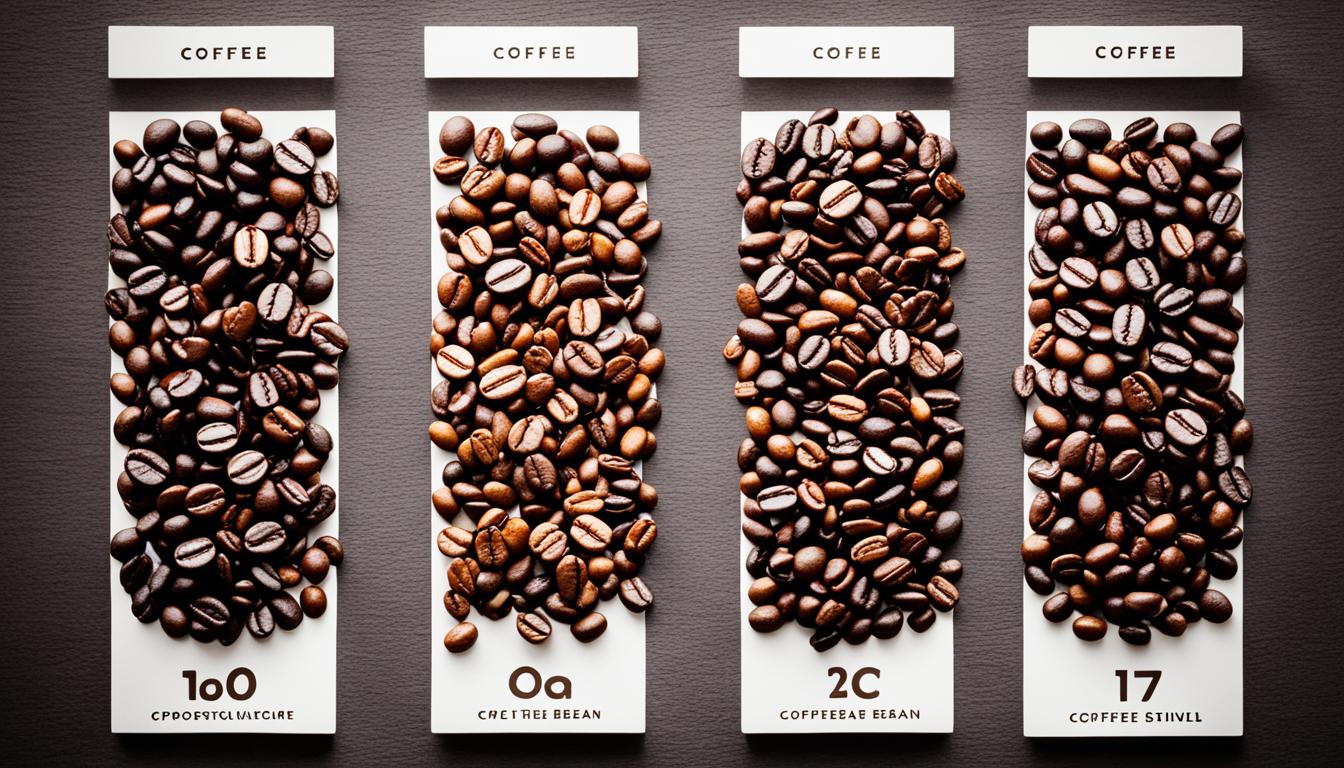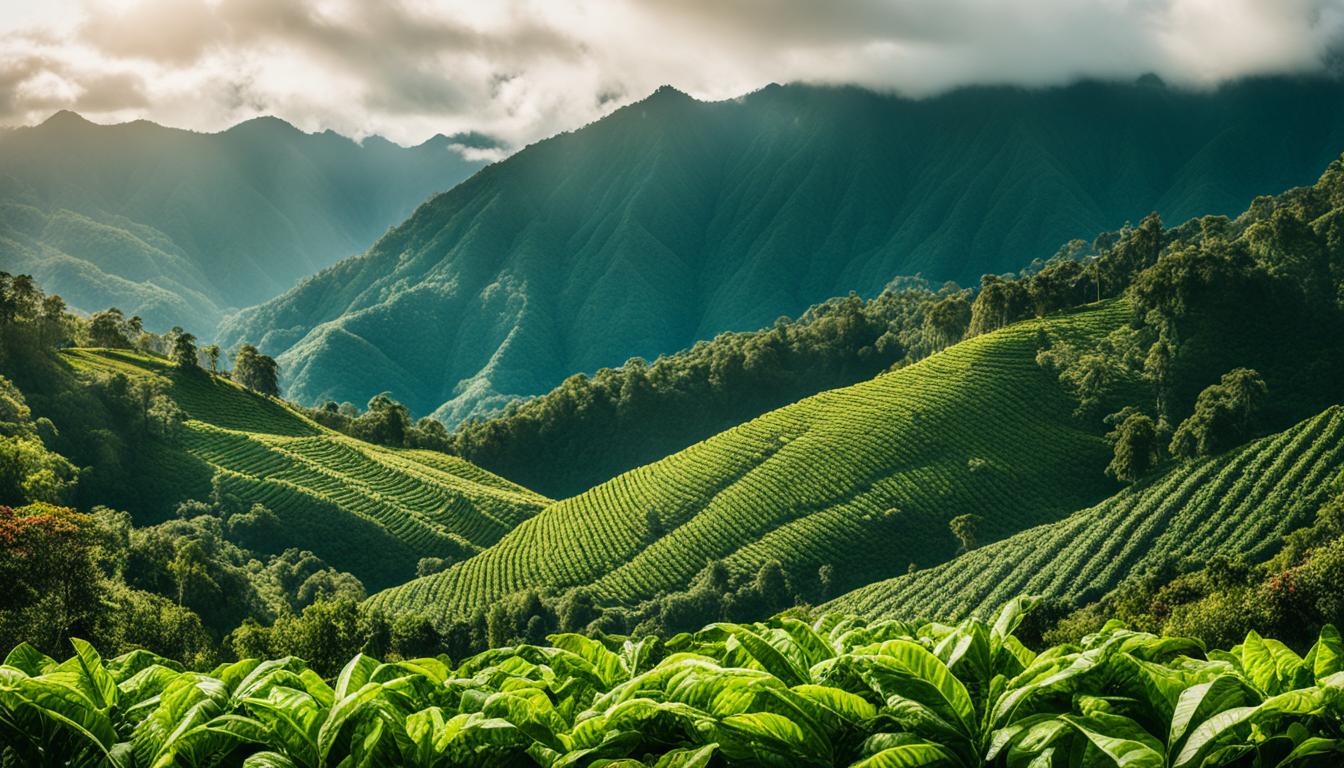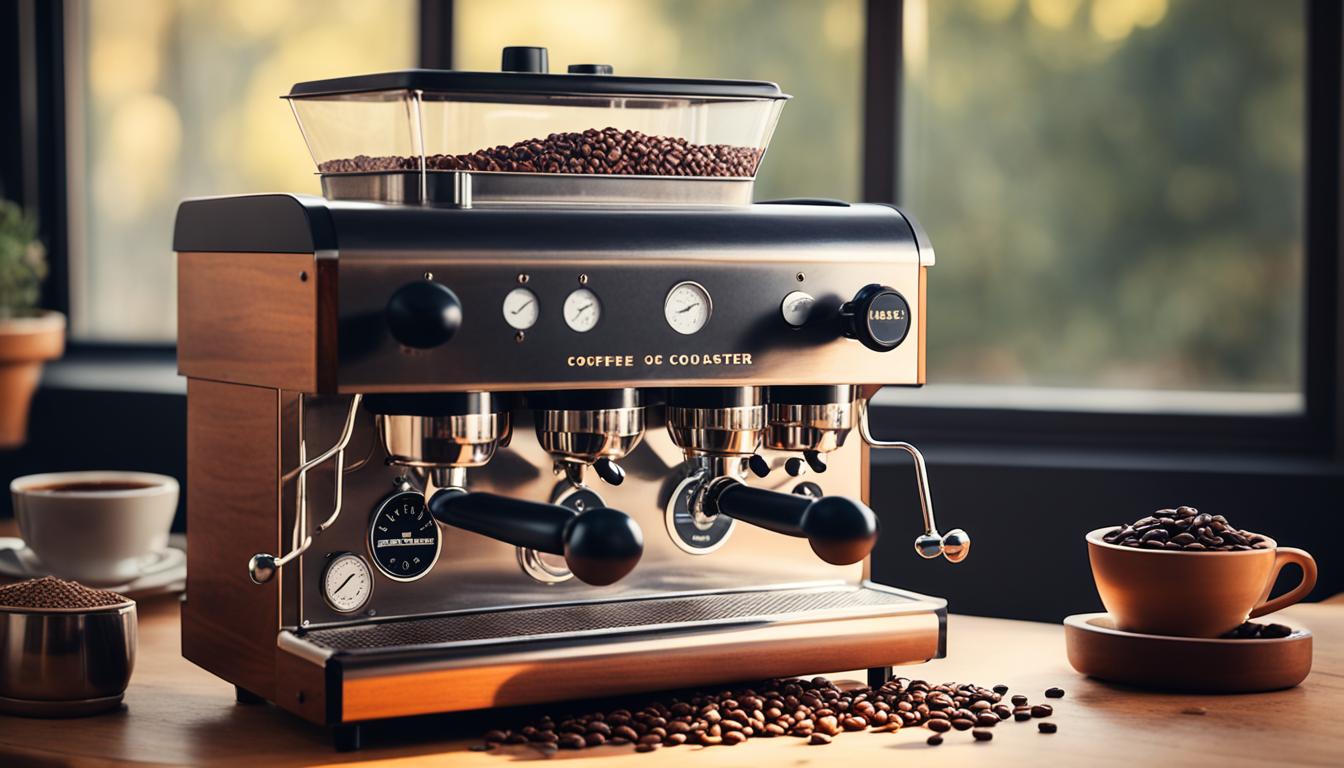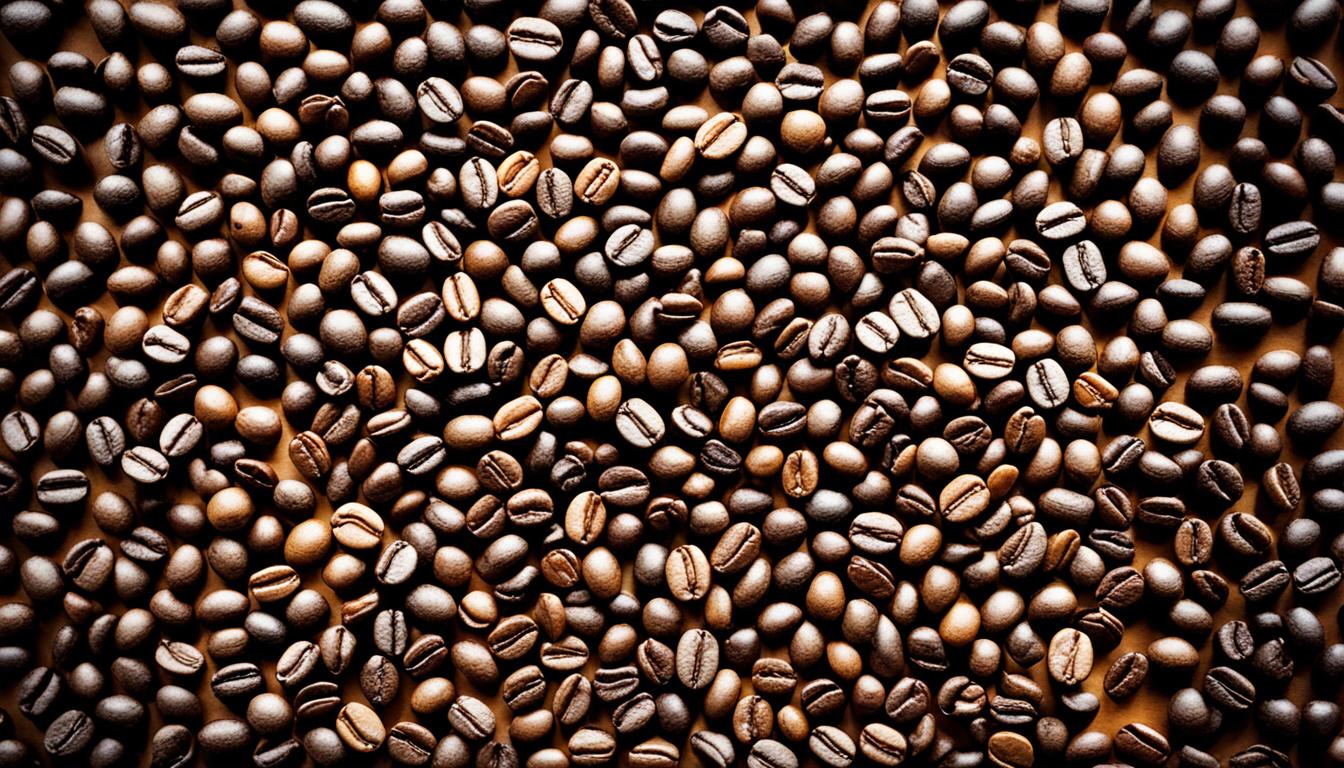Roasting is a crucial step in the coffee production process that transforms green coffee beans into the aromatic and flavorful coffee beans we know and love. It brings out the unique characteristics and flavors locked inside the beans. Roasting is both an art and a science, requiring expertise and precision to achieve the perfect roast. There are different levels of roasting that determine the flavor, aroma, and color of the coffee, including light roast, medium roast, and dark roast.
Key Takeaways:
- Roasting is a crucial step that brings out the unique flavors and characteristics of coffee beans.
- There are three main roasting levels: light roast, medium roast, and dark roast.
- Light roast coffee has a light brown color and a mild flavor profile, retaining delicate aromas and higher caffeine concentration.
- Medium roast coffee has a medium brown color and offers a balanced flavor profile, preferred by many for its smooth taste.
- Dark roast coffee has a dark and shiny black color, with a bold and intense flavor profile and lower acidity.
Exploring the Delicate Flavors of Light Roast Coffee
Light roast coffee is known for its delicate flavors and light brown color. It is the perfect choice for those who prefer a milder taste profile.
During the roasting process, green coffee beans are heated for a shorter duration, resulting in a light roast. These beans are often soft and spongy and do not develop oils on the surface, making them appear dry. The absence of oil preserves the natural flavors and acidity of the beans, bringing out the unique characteristics of the coffee.
Light roast coffee is incredibly versatile, as it allows the distinct flavors of different coffee origins to shine through. This roast level is commonly associated with regions known for producing exceptional coffee, such as Ethiopia and Costa Rica.
Light roast coffee retains the delicate aromas and bright acidity of the coffee beans, offering a refreshing and vibrant drinking experience.
Some popular light roast profiles include Light City, Half City, and Cinnamon roast. Each profile offers unique characteristics that appeal to different taste preferences.
- Light City: This roast level is a perfect balance between light and medium. It showcases the delicate flavors of the beans while adding a subtle sweetness.
- Half City: This roast presents a lighter and slightly fruity flavor profile. It highlights the bright acidity and floral notes of the coffee beans.
- Cinnamon Roast: Considered the lightest of all, this roast level exhibits a light brown color, a soft and mellow flavor, and a delightful aroma of toasted grains.
Contrary to popular belief, light roast coffee contains slightly higher caffeine concentration compared to dark roast coffee. The shorter roasting time preserves more caffeine in the beans, resulting in a slightly higher caffeine content.
Light roast coffee offers a mild yet flavorful cup, with a delightful balance of acidity and brightness. It is the perfect choice for coffee enthusiasts who appreciate the nuanced and intricate flavors of different coffee origins.
Next, let’s dive into the balanced flavor of medium roast coffee in Section 3.
Discovering the Balanced Flavor of Medium Roast Coffee
When it comes to coffee, the medium roast strikes the perfect balance between the natural characteristics of the coffee bean and the roasting process. With its medium brown color, this roast level offers a delightful combination of flavors that coffee enthusiasts can’t resist.
Medium roast coffee is known for its balanced flavor profile, which brings together the sweetness of lighter roasts and the richness of darker roasts. It has a moderate acidity that adds a pleasant tang without overpowering the taste buds. The result is a smooth and well-rounded cup of coffee that satisfies both newbies and avid coffee drinkers.
What sets medium roast coffee apart is its non-oily surface. Unlike dark roasts, which develop a shiny black appearance due to the oils on their surface, medium roast beans remain non-oily. This distinction creates a cleaner finish and ensures that the flavors are more pronounced and distinct.
The medium roast goes by several names, including American roast or City roast. These names pay homage to the coffee’s popularity in the United States, where it is a preferred choice for breakfast or as an everyday coffee option. Its versatility allows it to pair well with various breakfast foods, such as pastries, eggs, and even pancakes.
“The balanced flavor of medium roast coffee appeals to many coffee lovers, making it a staple in our morning routines.” – Mary Smith, Coffee Connoisseur
H3: How to Brew an Exceptional Cup of Medium Roast Coffee
Brewing a great cup of medium roast coffee is as important as selecting the right beans. Here’s a simple guide to help you extract the best flavors from your medium roast:
- Choose high-quality medium roast coffee beans that are freshly roasted for maximum flavor.
- Grind the beans right before brewing to preserve the aromatic compounds.
- Use a water temperature between 195-205°F (90-96°C) to ensure proper extraction.
- Experiment with different brewing methods, such as pour-over, French press, or a traditional coffee maker, to find your preferred brewing style.
- Savor the balanced flavors and aromas of your medium roast coffee.
Remember, brewing coffee is an art that allows you to customize your coffee experience and bring out the best in each cup. Don’t be afraid to explore and experiment to find the perfect brewing method for your taste preferences.
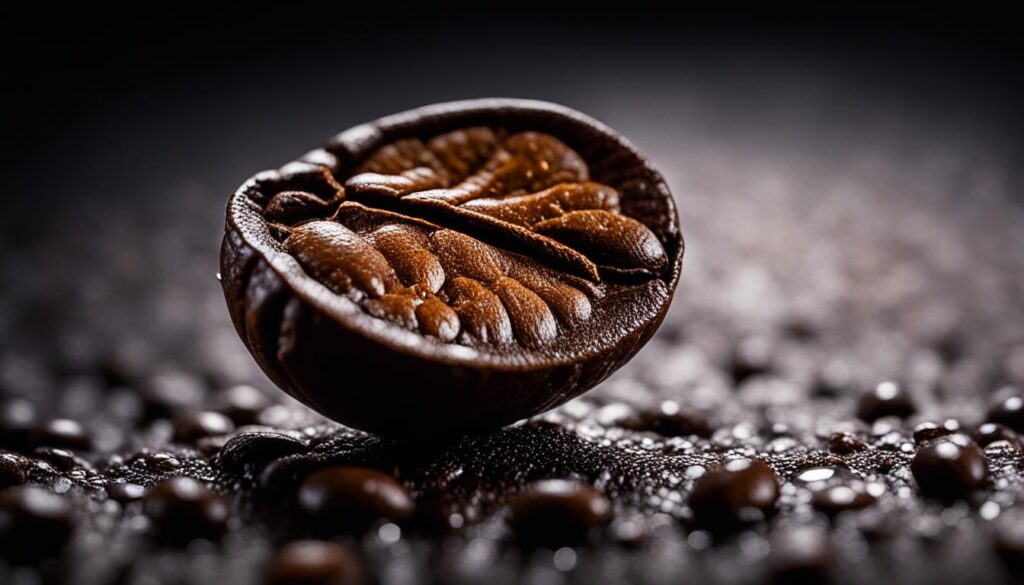
A Comparison of Coffee Roast Levels
| Roast Level | Roast Color | Flavor Profile | Roast Surface |
|---|---|---|---|
| Light Roast | Light brown | Delicate, aromatic | No oil on surface |
| Medium Roast | Medium brown | Balanced, smooth | Non-oily surface |
| Dark Roast | Dark brown to black | Intense, bold | Oily surface |
Table: A Comparison of Coffee Roast Levels
When comparing coffee roast levels, it’s clear that the medium roast occupies the middle ground. It offers a balance between the delicate flavors of light roasts and the boldness of dark roasts. With its medium brown color and non-oily surface, medium roast coffee is a versatile option that pleases a wide range of palates.
Whether you prefer a strong breakfast brew or a smooth cup to kickstart your day, medium roast coffee delivers in both flavor and satisfaction. Get ready to savor the perfectly balanced flavors that only a medium roast can offer.
Indulging in the Bold Flavors of Dark Roast Coffee
Dark roast coffee is a treat for the senses, offering a bold and intense flavor profile that coffee enthusiasts can’t resist. This roast level is characterized by its shiny black beans with an oily surface, which are a result of the prolonged roasting process. When you brew a cup of dark roast coffee, you’ll notice its pronounced bitterness and low acidity, creating a robust and full-bodied experience.
The dark roast spectrum encompasses a range of intensities, starting from slightly dark to charred. Each level has its own distinctive flavor notes and characteristics. Some popular dark roast names include Full City, High, Continental, Espresso, French, and Italian, among many others. These roasts are well-suited for those who crave a rich and flavorful cup of coffee.
When enjoying a cup of dark roast coffee, you’ll be greeted by the deep, aromatic fragrance that fills the air as you savor every sip. The dark and shiny black beans tell a story of their own, signifying the intensified flavors and the dedication put into crafting the perfect roast.
“Dark roast coffee is like fine art. It requires skill and precision to bring out the desired flavors without crossing the line into bitterness.”
Due to the extended roasting time, dark roast coffee generally has a lower caffeine content compared to lighter roast levels. This makes it a great choice for those who prefer a less stimulating cup or want to enjoy a late-night coffee without worrying about sleep disturbances.
Dark roast coffee is versatile and can be enjoyed in a variety of brewing methods. Its bold characteristics and rich flavors make it particularly well-suited for espresso blends. So whether you’re a fan of the strong continental espresso or prefer the traditional flavors of French and Italian roasts, dark roast will provide a truly indulgent coffee experience.
The Characteristics of Dark Roast Coffee:
- Pronounced bitterness and low acidity
- Rich, robust flavor profile
- Shiny black beans with an oily surface
- Dark roast names: Full City, High, Continental, Espresso, French, Italian, and more
- Lower caffeine content compared to lighter roast levels
- Well-suited for espresso blends and various brewing methods
Unveiling the Science Behind Coffee Roasting
The roasting process is a fascinating journey that involves a delicate balance of science and art. During this transformation, chemical changes take place as the coffee beans undergo temperature fluctuations, resulting in the development of unique flavors and aromas.
As the journey begins, green coffee beans are carefully heated, causing them to undergo a series of transformations. It is during this roasting process that the magic happens, bringing out the true essence of the coffee beans.
One of the defining moments in the roasting process is the first crack. This occurs when the beans reach a specific temperature, causing them to expand and emit a popping sound. It’s a significant milestone that marks the progression of the roasting process.
Following the first crack, the beans continue to be exposed to heat until they reach the second crack. This is another crucial stage where the beans release more oils and undergo further transformations. The second crack is characterized by a more pronounced cracking sound and signals the attainment of a different roast level.
The roasting process also impacts the caffeine content of the coffee. Contrary to popular belief, darker roasts actually contain less caffeine than their lighter counterparts. The intense heat and longer roasting time cause some of the caffeine to be lost in the process.
Additionally, the roasting process plays a fundamental role in the development of oils on the surface of the beans. These oils add depth and complexity to the flavors of the coffee. Darker roasts tend to have more noticeable oil development, while lighter roasts have a drier appearance.
Moreover, the roasting process significantly influences the final characteristics of the coffee roast. It determines the flavor profiles, aromas, and body of the coffee. From floral and fruity to rich and chocolaty, the possibilities are endless, and it all depends on the roasting technique and duration.
To summarize, coffee roasting is a remarkable process driven by chemistry and temperature. The journey from green coffee beans to the perfectly roasted beans involves chemical changes, temperature fluctuations, and the development of distinct roast characteristics. It is through this process that we unlock the incredible flavors and aromas that make each cup of coffee a truly unique and enjoyable experience.
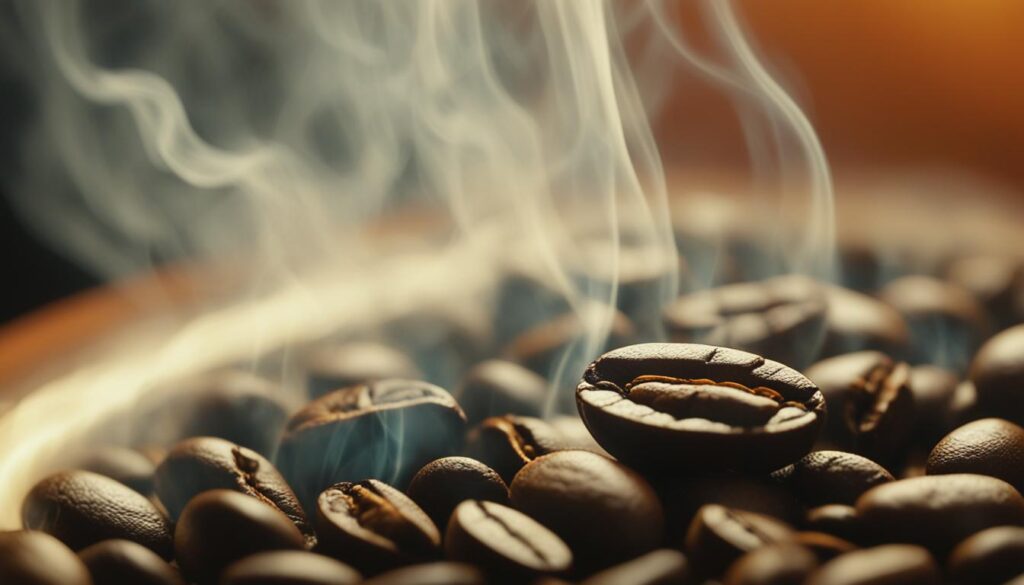
| Roasting Process Highlights |
|---|
| Chemical changes |
| Temperature fluctuations |
| First crack |
| Second crack |
| Caffeine content variation |
| Oil development |
| Roast characteristics |
Exploring Personal Preferences in Coffee Roasts
The enjoyment of coffee is a deeply personal experience, and choosing the right roast is essential to satisfy individual taste preferences. Some coffee lovers savor the bright acidity and intricate flavors of light roasts, which highlight the unique characteristics of the beans. On the other hand, there are those who crave the robustness and bold flavors found in dark roasts.
For those seeking a harmonious balance between flavors, medium roasts offer a delightful compromise. With their moderate acidity and well-rounded profiles, medium roasts appeal to a wide range of coffee enthusiasts.
But how do you determine the roast level that suits your palate best? The answer lies in experimentation. By exploring different roast levels, you can discover the flavor profiles that resonate with your personal taste. Whether you prefer a delicate and bright cup or a full-bodied and intense brew, there is a roast out there to satisfy your preference.
It’s worth noting that roast names and descriptions may vary across different roasters. To ensure you select the roast level that aligns with your preferences, focus on the actual roast level rather than relying solely on the name or description. By prioritizing the roast level, you can confidently explore and enjoy the world of coffee to its fullest.
FAQ
What is coffee bean roasting?
Coffee bean roasting is the process of transforming green coffee beans into flavorful and aromatic coffee beans through heating. It brings out the unique characteristics and flavors locked inside the beans.
What are the different levels of coffee bean roasting?
There are three main levels of coffee bean roasting: light roast, medium roast, and dark roast. Each level has its own distinct flavor, aroma, and color.
What is a light roast coffee?
Light roast coffee is light brown in color and has a mild flavor profile. It retains the delicate aromas and bright acidity of the coffee beans. Examples of light roast coffee include Light City, Half City, and Cinnamon roast.
What is a medium roast coffee?
Medium roast coffee is medium brown in color and offers a balanced flavor profile. It has a non-oily surface and is commonly referred to as American roast or City roast. It is preferred by many due to its smooth taste and moderate acidity.
What is a dark roast coffee?
Dark roast coffee is characterized by its dark and shiny black beans with an oily surface. It offers a bold and intense flavor profile with pronounced bitterness. Dark roast coffees can range from slightly dark to charred and are commonly used for espresso blends.
How does coffee roasting influence the flavor and aroma of the coffee?
The roasting process plays a significant role in the development of flavors, aromas, and body of the coffee. Light roasts retain delicate flavors and bright acidity, while dark roasts offer bold and robust flavors with low acidity.
Does the roast level affect the caffeine content of the coffee?
Yes, the roast level does affect the caffeine content of the coffee. Contrary to popular belief, light roast coffee actually contains slightly higher caffeine concentration compared to dark roast coffee.
How should I choose the right coffee roast for my taste?
The choice of coffee roast is highly subjective and depends on individual preferences. Some prefer the bright acidity of light roasts, while others enjoy the boldness of dark roasts. Medium roasts offer a balanced flavor profile. It’s best to experiment with different roast levels to find the one that suits your taste preferences and enhances your coffee enjoyment.
What should I consider when selecting coffee based on roast levels?
When selecting coffee based on roast levels, it’s important to rely on the actual roast level rather than the name. Roast names and descriptions may vary between roasters. Pay attention to the roast color and description to ensure it aligns with your preferred flavor profile.
Can you explain the science behind coffee roasting?
Coffee roasting is a complex process that involves various chemical changes and temperature fluctuations. The beans undergo transformations, including the first crack and second crack, at specific temperatures. The roasting process also affects the caffeine content and the development of oils on the surface of the beans, which contribute to the flavor and aroma of the coffee.

